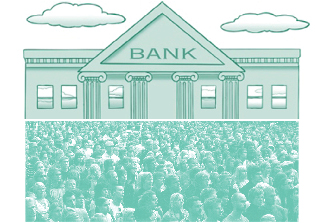
By Finance New Mexico
With tighter credit standards that have resulted in fewer loans since the recession of 2008, some are backing an effort to open a publicly owned and managed bank in New Mexico. These advocates are holding a symposium in Santa Fe on Sept. 27 to educate the public and decide how to proceed.
State Rep. Brian Egolf (D-Santa Fe) has pushed for a statewide public bank for years, arguing it would keep more money at home and make it easier for businesses to secure capital. Fellow legislators have rejected the idea for two successive years, so backers have scaled down the idea to a publicly owned bank in just one New Mexico community: Santa Fe. They have the support of the city’s mayor, Javier Gonzales, who sees it as a resource for cash-strapped local businesses.
Some local bankers are skeptical, citing capital availability but little loan demand from business owners reluctant to take on more debt before they see a strong turnaround in the economy.
Banking on New Mexico, a co-sponsor of the New Mexico initiative, points to the Bank of North Dakota to make its case. Founded in 1919 to insure affordable credit for North Dakota farmers, ranchers and businesses, BND is capitalized by state assets and is the repository for all state revenues. The bank extends low-interest loans to students, startups and small businesses and cooperates with private banks to extend mortgages and other loans.
As a public bank, BND pays dividends to the state; in the past decade, it has returned $300 million to the state’s general fund. Most states invest revenues in big institutions based out of state, which can cost millions in fees, according to We Are People Here!, a symposium co-sponsor. “Community banks will benefit if their reserves are backed by a publicly owned bank with interest rates set to maximize public good in this state rather than global investment strategies,” according to the group’s website.
Chip Chippeaux, chairman of locally owned Century Bank, suspects the initiative is a pushback against the big banks, which have tightened lending in recent years. But starting a public bank is complicated, he said. Currently, the state must issue a request for proposal to contract for banking services; local banks that have considered previous RFPs found insufficient margin to make money contracting with the state because they don’t have the scale or scope to make it efficient.
But Chippeaux was intrigued by the opportunities to participate in shared loans. Century Bank’s internal and external limits dictate individual loan sizes; if the public bank could participate with Century in a larger loan, he said, “this could be interesting.”
Backers of the idea say it’s premature to work out the details before people understand the concept. Co-sponsors We Are People Here! and the Public Banking Institute aim to educate at the symposium, “Banking on New Mexico: Funding Local, Sustainable Economies.” The event will take place at the Santa Fe Community Convention Center. A full list of speakers is at http://www.wearepeoplehere.org/symposium/.
Download 364_Public Banking Gets a Hearing at Symposium PDF

Bad idea. Political decision making on financial transactions. Low grade credits made. Becomes a central bank without money issuing authority beyond the fractional reserve to cover deficit spending, even though a balanced budget is mandatory.
We are fortunate to have this National Symposium in Santa Fe with National and International speakers with answers to most objections. Risks are low. Profits stay local. Lending decisions are made by experienced bankers. Community banks are helped – not competed with. Public Banking (as opposed to Private Banking in most of the US and UK) represents 40% of World Trade. Canada, New Zealand, Germany, France, Australia, et al have all had good results. It is a concept worth learning about.